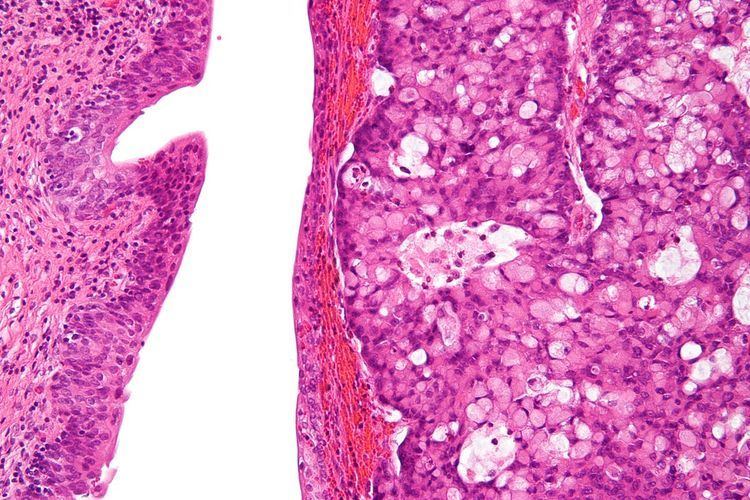eMedicine radio/727 | ||
 | ||
Urachal cancer is a very rare type of cancer arising from the urachus or its remnants. The disease might arise from metaplasic glandular epithelium or embryonic epithelial remnants originating from the cloaca region.
Contents
It occurs in roughly about one person per 1 million people per year varying on the geographical region. Men are affected slightly more often than women mostly in the 5th decade of life but the disease can occur in also in other age groups.
It can involve the urinary bladder, but is not bladder cancer in the usual sense. Urachal cancer can occur at any site along the urachal tract.
Urachal cancer was mentioned by Hue and Jacquin in 1863 followed by an elaborate work by T. Cullen in 1916 about diseases of the umbilicus, while C. Begg further characterized urachal cancer in the 1930s. Detailed diagnostic and staging schemes were proposed by Sheldon et al in 1984, which remain widely used today.
Symptoms
Urachal cancer can exist for some years without any symptoms. The most frequent initial symptom is haematuria, but mucinuria (mucin in the urine), local pain or swelling, recurrent local or urinary tract infections and umbilical discharge can be seen.
Diagnosis
The diagnosis of urachal cancer can be difficult and usually requires a multidisciplinary approach. A calcification in the midline can be detected in some patients in abdominal imaging studies. A cystoscopy is helpful in most cases. For diagnosis evaluation of a tissue biopsy is needed, which is usually obtained by transurethral resection (TURBT). Measurement of serum concentrations of CEA, CA19-9 and CA125 can be helpful in monitoring urachal cancer
Histopathology
Urachal cancer usually is an adenocarcinoma (about 90%) mostly with mucinous/colloidal histology. The histology can be difficult to distinguish especially from colorectal cancer and primary adenocarcinoma of the urinary bladder. Immunohistochemistry in this situation is of little help with stains for betaCatenin and Cytokeratin 7 can be helpful. Other rare types include urothelial carcinoma, squamous cell carcinoma, neuroendocrine carcinoma and sarcoma.
Diagnostic systems in use are the Sheldon system based on proposals from Wheeler and Hill and Mostofi. Recent diagnostic classification schemes have been proposed by Herr et al and Gopalan et al. For non-adenocarcinoma urachal cancer a diagnostic classification scheme has been proposed by Paner et al.
Treatment
Surgery is the mainstay of treatment for clinically localized disease. In feasible cases, a partial cystectomy with en-bloc resection of the median umbilical ligament and umbilicus can achieve good results. In progressed stages, radiotherapy seems not to lead to sufficient response rates. However, chemotherapy regimes containing 5-FU (and Cisplatin) have been described to be useful in these cases. In recent years, targeted therapies have been demonstrated to be useful in reports of single cases. These agents included Sunitinib, Gefitinib, Bevacizumab and Cetuximab.
Prognosis
The median overall survival rate is about 50% in 5 years. Worse prognostic factors include the presence of residual tumor at the margin of the resection specimen (R+), invasion of the peritoneum and metastatic disease.
